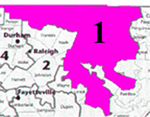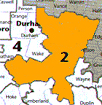| North Carolina’s Political Lineup
|
Redistricting Deadline The deadline for state legislative districts is the end of the first legislative session after the return of the census. There is no specific deadline for congressional districts, but the practical deadline for both plans is far enough before the first Monday in January -- which is the beginning of the candidate-qualifying period for primaries – that the Department of Justice has time to preclear the plans. | Who’s in Charge of Redistricting? The legislature. There is no gubernatorial veto power over redistricting plans. | ||||||||||||||||||||||||
Districting Principles
+ = required - = prohibited a=allowed | Public Access The General Assembly's "DistrictBuilder" redistricting computer system is is available for public use. This access was available at the state library in Raleigh in the 1990’s. The state's Redistricting Public Input page has information on how to reserve a time slot to use the system, as well as detailed information on public hearings and how to submit comments on the proposed plans. Also see the state's general Redistricting page. | ||||||||||||||||||||||||
Political Landscape North Carolina’s tortuous decade of litigation and repeated court requirements to draw new congressional maps has created a reform climate in the state. Legislators of both parties have proposed bills on redistricting commissions, while Congressman Mel Watt – representative of the controversial 12th district – in 1999 introduced a bill that would have allowed multi-seat congressional districts (HR 1173, the States’ Choice of Voting Systems Act).
By losing control of the house in 2000, the Republicans lost a direct voice in redistricting. Because Democrats spread their voters too thinly in 1991-92, contributing to several close losses and near losses in 1994, the recent history of bi-partisan efforts to protect most incumbents may well continue in 2001. With one new district, minority voting rights advocates may seek three minority-opportunity districts rather than the current two. | The First Version:
The first formulation of the 12th CD was in response to the Department
of Justice's rejection of North Carolina's original congressional plan
containing only one majority-black district. The 12th district was the
result of the Democratic-controlled legislature's attempt to create a
second majority-black district while maintaining a partisan advantage.
The plan with the new 12th, majority-black district was precleared, but
challenged in federal court by a Duke University Law professor. In Shaw v. Reno,
the U.S. Supreme Court ruled on appeal that the federal district court
had improperly dismissed the claim and that racial gerrymanders may
violate the Equal Protection Clause under some circumstances. The case
was remanded back to the district court in order to determine the case
on its merits. On remand, the federal district court found that the 12th was drawn to serve North Carolina's compelling interest to satisfy section 2 and section 5 of the Voting Rights Act. The U.S. Supreme Court again reversed the district court, ruling that although the Voting Rights Act is a legitimate and compelling state interest, the drawing of the 12th was not narrowly-tailored or precisely formulated to serve that purpose. The district court instructed the North Carolina legislature to draw a plan, and required it to be in place in time for the 1998 elections. The Second Version: The new 12th retained its elongated shape and was enacted by the North Carolina legislature in 1997. However, a three-judge federal panel upheld a request for a permanent injunction against using the revised 12th in the 1998 congressional elections. The court's decision echoed the previous Supreme Court opinion, noting that the predominant factor in the new 12th's configuration was again, race. The North Carolina Legislature, for the third time, created a 12th congressional district. The Third Version: The third version of the 12th CD case reached the Supreme Court in 1999. The court again reversed the lower court, this time on it granting summary judgment in favor of the plaintiffs in early 1998. Justice Thomas wrote that the lower court too quickly resolved the case in the plaintiffs’ favor when the defendants had submitted credible evidence that the second version of the 12th was drawn using politics as the predominant factor rather than race – the legislature had been very clear that it was seeking to protect all incumbents. The case was remanded, where the lower court concluded after a trial, that the second version of the 12th was an unconstitutional racial gerrymander. North Carolina was again, ordered to continue use of the third version of the 12th district. The Supreme Court stayed this order on March 7, 2000, and in November 2000 reversed the lower court.
There also were failed challenges to North Carolina’s congressional plan based on partisan gerrymandering. The state legislative plan was unsuccessfully challenged as a racial gerrymander. | ||||||||||||||||||||||||
Legal Issues Perhaps the most famous Supreme Court case in redistricting hails from North Carolina. The 12th congressional district, also known as the "I-85" district, has been considered by the U.S. Supreme Court four times in various configurations and once again is the subject of a federal trial in the fall of 2000. The case can be reviewed in three parts. Legislation/Reform Efforts Several bills were introduced in the North Carolina legislature that provided for redistricting commissions, but no legislation was successful. There also have been relatively popular, but ultimately unsuccessful efforts to convert all multi-seat state legislative districts to single-member districts.
|
Irregularly Shaped District | Irregularly Shaped District | Irregularly Shaped District |
|
|
|
· Northeast section of state · Poor and rural—one of the poorest in the nation · Strongly Democratic · 49% white; 50% black; 1% Hispanic | · Central—include parts of Raleigh · Had to be redrawn for the 106th Congress—made more suburban and slightly less Democratic · 70% white; 28% black; 1% Asian; 1% Hispanic | · Shape was changed drastically in court-ordered redistricting · Leans Democratic, with some Republicans at local level · 63% white; 36% black; 1% Asian; 1% Hispanic |



